《西方经济学》课程PPT教学课件(微观经济学)Chapter 08 Profit Maximization and Competitive Supply
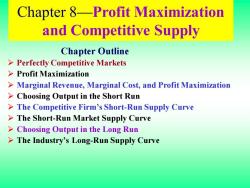
Chapter 8-Profit Maximization and Competitive Supply Chapter Outline Perfectly Competitive Markets Profit Maximization Marginal Revenue,Marginal Cost,and Profit Maximization >Choosing Output in the Short Run The Competitive Firm's Short-Run Supply Curve The Short-Run Market Supply Curve >Choosing Output in the Long Run The Industry's Long-Run Supply Curve
Chapter 8—Profit Maximization and Competitive Supply Chapter Outline ➢ Perfectly Competitive Markets ➢ Profit Maximization ➢ Marginal Revenue, Marginal Cost, and Profit Maximization ➢ Choosing Output in the Short Run ➢ The Competitive Firm’s Short-Run Supply Curve ➢ The Short-Run Market Supply Curve ➢ Choosing Output in the Long Run ➢ The Industry’s Long-Run Supply Curve
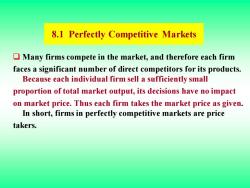
8.1 Perfectly Competitive Markets Many firms compete in the market,and therefore each firm faces a significant number of direct competitors for its products. Because each individual firm sell a sufficiently small proportion of total market output,its decisions have no impact on market price.Thus each firm takes the market price as given. In short,firms in perfectly competitive markets are price takers
8.1 Perfectly Competitive Markets ❑ Many firms compete in the market, and therefore each firm faces a significant number of direct competitors for its products. Because each individual firm sell a sufficiently small proportion of total market output, its decisions have no impact on market price. Thus each firm takes the market price as given. In short, firms in perfectly competitive markets are price takers
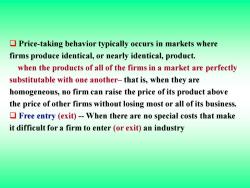
Price-taking behavior typically occurs in markets where firms produce identical,or nearly identical,product. when the products of all of the firms in a market are perfectly substitutable with one another-that is,when they are homogeneous,no firm can raise the price of its product above the price of other firms without losing most or all of its business. Free entry(exit)-When there are no special costs that make it difficult for a firm to enter(or exit)an industry
❑ Price-taking behavior typically occurs in markets where firms produce identical, or nearly identical, product. when the products of all of the firms in a market are perfectly substitutable with one another– that is, when they are homogeneous, no firm can raise the price of its product above the price of other firms without losing most or all of its business. ❑ Free entry (exit) - When there are no special costs that make it difficult for a firm to enter (or exit) an industry
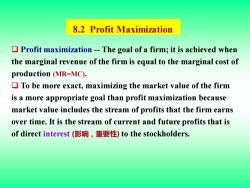
8.2 Profit Maximization Profit maximization-The goal of a firm;it is achieved when the marginal revenue of the firm is equal to the marginal cost of production (MR=MC). To be more exact,maximizing the market value of the firm is a more appropriate goal than profit maximization because market value includes the stream of profits that the firm earns over time.It is the stream of current and future profits that is of direct interest(影响,重要性)to the stockholders
8.2 Profit Maximization ❑ Profit maximization - The goal of a firm; it is achieved when the marginal revenue of the firm is equal to the marginal cost of production (MR=MC). ❑ To be more exact, maximizing the market value of the firm is a more appropriate goal than profit maximization because market value includes the stream of profits that the firm earns over time. It is the stream of current and future profits that is of direct interest (影响,重要性) to the stockholders
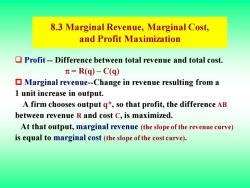
8.3 Marginal Revenue,Marginal Cost, and Profit Maximization Profit-Difference between total revenue and total cost. 元=R(q)-C(q) Marginal revenue-Change in revenue resulting from a 1 unit increase in output. A firm chooses output q*,so that profit,the difference AB between revenue R and cost C,is maximized. At that output,marginal revenue (the slope of the revenue curve) is equal to marginal cost (the slope of the cost curve)
8.3 Marginal Revenue, Marginal Cost, and Profit Maximization ❑ Profit - Difference between total revenue and total cost. = R(q) – C(q) Marginal revenue-Change in revenue resulting from a 1 unit increase in output. A firm chooses output q*, so that profit, the difference AB between revenue R and cost C, is maximized. At that output, marginal revenue (the slope of the revenue curve) is equal to marginal cost (the slope of the cost curve)

Cost Revenue, C(q) Profit (dollars A per year) R(q) 90 9¥ 元(q) Output (units per year) Profit Maximization in the short Run
(q) q0 q* R(q) C(q) Output (units per year) Profit Maximization in the short Run Cost Revenue, Profit (dollars per year) B A
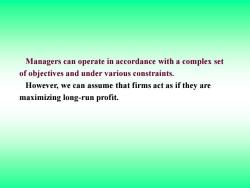
Managers can operate in accordance with a complex set of objectives and under various constraints. However,we can assume that firms act as if they are maximizing long-run profit
Managers can operate in accordance with a complex set of objectives and under various constraints. However, we can assume that firms act as if they are maximizing long-run profit
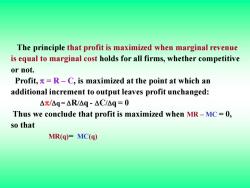
The principle that profit is maximized when marginal revenue is equal to marginal cost holds for all firms,whether competitive or not. Profit,n=R-C,is maximized at the point at which an additional increment to output leaves profit unchanged: △π/△q=△R/△q-△C/△q=0 Thus we conclude that profit is maximized when MR-MC=0, so that MR(q)=MC(q)
The principle that profit is maximized when marginal revenue is equal to marginal cost holds for all firms, whether competitive or not. Profit, = R – C, is maximized at the point at which an additional increment to output leaves profit unchanged: /q = R/q - C/q = 0 Thus we conclude that profit is maximized when MR – MC = 0, so that MR(q)= MC(q)
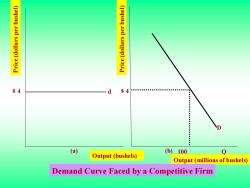
$4 (a) (b)100 Q Output(bushels) Output(millions of bushels) Demand Curve Faced by a Competitive Firm
D 100 Q ﹩4 Output (millions of bushels) Output (bushels) Price (dollars per bushel) Price (dollars per bushel) Demand Curve Faced by a Competitive Firm ﹩4 d (a) (b)
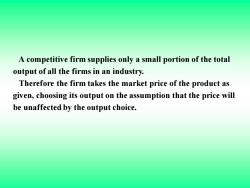
A competitive firm supplies only a small portion of the total output of all the firms in an industry. Therefore the firm takes the market price of the product as given,choosing its output on the assumption that the price will be unaffected by the output choice
A competitive firm supplies only a small portion of the total output of all the firms in an industry. Therefore the firm takes the market price of the product as given, choosing its output on the assumption that the price will be unaffected by the output choice
按次数下载不扣除下载券;
注册用户24小时内重复下载只扣除一次;
顺序:VIP每日次数-->可用次数-->下载券;
- 《西方经济学》课程PPT教学课件(微观经济学)Chapter 07 The Cost of Production.ppt
- 《西方经济学》课程PPT教学课件(微观经济学)Chapter 06 Production.ppt
- 《西方经济学》课程PPT教学课件(微观经济学)Chapter 05 Choice under Uncertainty.ppt
- 《西方经济学》课程PPT教学课件(微观经济学)Chapter 04 Individual and Market Demand.ppt
- 《西方经济学》课程PPT教学课件(微观经济学)Chapter 03 Consumer Behavior.ppt
- 《西方经济学》课程PPT教学课件(微观经济学)Chapter 02 The Basics of Supply and Demand.ppt
- 《西方经济学》课程PPT教学课件(微观经济学)Chapter 01 Preliminaries.ppt
- 《西方经济学》课程PPT教学课件(宏观经济学)Chapter 19 Advances in Business Cycle theory.ppt
- 《西方经济学》课程PPT教学课件(宏观经济学)Chapter 17 Investment.ppt
- 《西方经济学》课程PPT教学课件(宏观经济学)Chapter 18 Money supply and monetary Policy.ppt
- 《西方经济学》课程PPT教学课件(宏观经济学)Chapter 16 Consumption.ppt
- 《西方经济学》课程PPT教学课件(宏观经济学)Chapter 15Government Debt and Budget Deficits.ppt
- 《西方经济学》课程PPT教学课件(宏观经济学)Chapter 14 Stabilization Policy.ppt
- 《西方经济学》课程PPT教学课件(宏观经济学)Chapter 13 Aggregate supply.ppt
- 《西方经济学》课程PPT教学课件(宏观经济学)Chapter 12 Aggregate demand in open economy.ppt
- 《西方经济学》课程PPT教学课件(宏观经济学)Chapter 11 Application of IS-LM model.ppt
- 《西方经济学》课程PPT教学课件(宏观经济学)Chapter 10 The IS-LM model.ppt
- 《西方经济学》课程PPT教学课件(宏观经济学)Chapter 09 Introduction to AS-AD model.ppt
- 《西方经济学》课程PPT教学课件(宏观经济学)Chapter 07 Economic growth(1/2).ppt
- 《西方经济学》课程PPT教学课件(宏观经济学)Chapter 08 Economic growth(2/2).ppt
- 《西方经济学》课程PPT教学课件(微观经济学)Chapter 09 The Analysis of Competitive Markets.ppt
- 《西方经济学》课程PPT教学课件(微观经济学)Chapter 10 Market Power.ppt
- 《西方经济学》课程PPT教学课件(微观经济学)Chapter 11 Pricing with Market Power.ppt
- 《西方经济学》课程PPT教学课件(微观经济学)Chapter 12 Monopolistic Competition.ppt
- 《西方经济学》课程PPT教学课件(微观经济学)Chapter 13 Game Theory.ppt
- 《西方经济学》课程PPT教学课件(微观经济学)Chapter 14 Markets for Factor Inputs.ppt
- 《西方经济学》课程PPT教学课件(微观经济学)Chapter 15 Investment, Time, and Capital.ppt
- 《西方经济学》课程PPT教学课件(微观经济学)Chapter 16 General Equilibrium and Economic Efficiency.ppt
- 《西方经济学》课程PPT教学课件(微观经济学)Chapter 17 Markets with Asymmetric Information.ppt
- 《西方经济学》课程PPT教学课件(微观经济学)Chapter 18 Externalities.ppt
- 《西方经济学》课程PPT教学课件(微观经济学)Chapter 17 Microeconomics.ppt
- 海南大学:《成本会计》课程课程教学大纲 COST ACCOUNTING.pdf
- 海南大学:《成本会计》课程教学资源(教案讲义)第一章 总论.doc
- 海南大学:《成本会计》课程教学资源(教案讲义)第三章 成本汇集与分配.doc
- 海南大学:《成本会计》课程教学资源(教案讲义)第二章 成本核算方法体系.doc
- 海南大学:《成本会计》课程教学资源(教案讲义)第五章 分步成本计算.doc
- 海南大学:《成本会计》课程教学资源(教案讲义)第六章 分类法.doc
- 海南大学:《成本会计》课程教学资源(教案讲义)第四章 单步骤成本计算方法.doc
- 海南大学:《成本会计》课程教学资源(教案讲义)第七章 作业成本计算.doc
- 海南大学:《成本会计》课程教学资源(教案讲义)第九章 标准成本法.doc
